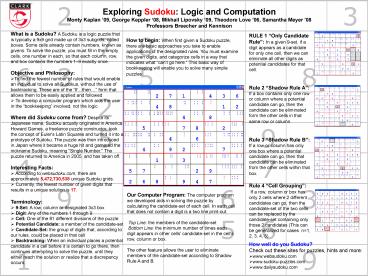Exploring Sudoku: Logic and Computation - PowerPoint PPT Presentation
1 / 1
Title:
Exploring Sudoku: Logic and Computation
Description:
A Sudoku is a logic puzzle that is typically a 9x9 grid made up of 3x3 ... it became a huge hit and garnered the nickname Sudoku, meaning 'Single Number. ... – PowerPoint PPT presentation
Number of Views:53
Avg rating:3.0/5.0
Title: Exploring Sudoku: Logic and Computation
1
Exploring Sudoku Logic and Computation Monty
Kaplan 09, George Keppler 08, Mikhail Lipovsky
09, Theodore Love 06, Samantha Meyer
08 Professors Breecher and Kennison
- What is a Sudoku? A Sudoku is a logic puzzle that
is typically a 9x9 grid made up of 3x3 subgrids,
called boxes. Some cells already contain numbers,
known as givens. To solve the puzzle, you must
fill in the empty cells, one number in each, so
that each column, row, - and box contains the numbers 19 exactly once.
- Objective and Philosophy
- To find the fewest number of rules that would
enable - an individual to solve all Sudokus, without the
use of backtracking. These are of the Ifthen
form that allows them to be easily applied and
followed - To develop a computer program which aids the
user in the bookkeeping involved, not the
logic. - Where did Sudoku come from? Despite its Japanese
name, Sudoku actually originated in America.
Howard Garnes, a freelance puzzle constructor,
took the concept of Euler's Latin Squares and
turned it into a prototype of Sudoku. The puzzle
was then introduced in Japan where it became a
huge hit and garnered the nickname Sudoku,
meaning "Single Number." The puzzle returned to
America in 2005, and has taken off. - Interesting Facts
- According to websudoku.com, there are
approximately 5,472,730,538 unique Sudoku grids. - Currently, the fewest number of given digits
that results in a unique solution is 17. - Terminology
- 9-Set A row, column or designated 3x3 box
- Digit Any of the numbers 1 through 9
- Cell One of the 81 different divisions of the
puzzle - Potential Candidate a member of the
candidate-set
RULE 1 Only Candidate Rule In a given 9-set,
if a digit appears as a candidate for only one
cell, then we can eliminate all other digits as
potential candidates for that cell. Rule 2
Shadow Rule A If a box contains only one row
or column where a potential candidate can go,
then the candidate can be eliminated form the
other cells in that same row or column. Rule 3
Shadow Rule B If a row or column has only one
box where a potential candidate can go, then that
candidate can be eliminated from the other cells
within that box. Rule 4 Cell Grouping If a
row, column or box has only 2 cells where 2
different candidates can go, then the
candidate-set of the two cells can be replaced by
the candidate-set containing only those 2
candidates (This can be generalized for cases
n1, 2, 3, 4, 5)
How to begin When first given a Sudoku puzzle,
there are basic approaches you take to enable
applications of the designated rules. You must
examine the given digits, and categorize cells in
a way that indicates what cant go here. This
basic way of bookkeeping will enable you to solve
many simple puzzles.
Our Computer Program The computer program we
developed aids in solving the puzzle by
calculating the candidate-set of each cell. In
each cell that does not contain a digit is a two
line print-out Top Line the members of the
candidate-set Bottom Line the minimum number of
times each digit appears in other cells
candidate-set in the cells row, column or box.
The other feature allows the user to eliminate
members of the candidate-set according to Shadow
Rule A and B.
- How well do you Sudoku?
- Check out these sites for puzzles, hints and
more - www.websudoku.com
- www.sudoku-puzzles.com
- www.dailysudoku.com































